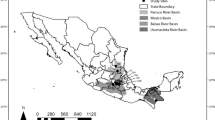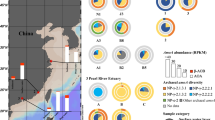Abstract
Treatment of environmental samples under field conditions may require the application of chemical preservatives, although their use sometimes produces changes in the microbial communities. Sodium azide, a commonly used preservative, is known to differentially affect the growth of bacteria. Application of azide and darkness incubation to Isabel soda lake water samples induced changes in the structure of the bacterial community, as assessed by partial 16S rRNA gene pyrosequencing. Untreated water samples (WU) were dominated by gammaproteobacterial sequences accounting for 86%, while in the azide-treated (WA) samples, this group was reduced to 33% abundance, and cyanobacteria-related sequences became dominant with 53%. Shotgun sequencing and genome recruitment analyses pointed to Halomonas campanensis strain LS21 (genome size 4.07 Mbp) and Synechococcus sp. RS9917 (2.58 Mbp) as the higher recruiting genomes from the sequence reads of WA and WU environmental libraries, respectively, covering nearly the complete genomes. Combined treatment of water samples with sodium azide and darkness has proven effective on the selective enrichment of a cyanobacterial group. This approach may allow the complete (or almost-complete) genome sequencing of Cyanobacteria from metagenomic DNA of different origins, and thus increasing the number of the underrepresented cyanobacterial genomes in the databases.


Similar content being viewed by others
References
Aguirre-Garrido JF, Ramírez-Saad HC, Toro N, Martínez-Abarca F (2016) Bacterial diversity in the soda saline crater lake from Isabel Island, Mexico. Microb Ecol 71(1):68–77. https://doi.org/10.1007/s00248-015-0676-6
Alcocer J, Lugo A, Sánchez MR, Escobar E (1998) Isabela crater-lake: a Mexican insular saline lake. Hydrobiologia 381:1–7
Alvarenga DO, Fiore MF, Varani AM (2017) A metagenomic approach to Cyanobacterial genomics. Front Microbiol 8:809. https://doi.org/10.3389/fmicb.2017.00809
Aronesty E (2011) Ea-utils: command-line tools for processing biological sequencing data; http://code.google.com/p/ea-utils
Audicana A, Perales I, Borrego JJ (1995) Modification of kanamycin-esculin-azide agar to improve selectivity in the enumeration of fecal streptococci from water samples. Appl Environ Microbiol 61:4168–4183
Bowyer JW, Skerman WBD (1968) Production of axenic cultures of soil-borne and endophytic blue-green algae. J Gen Microbiol 54:299–306
Bundy DA, , Golden MH. (1985). Sodium azide preservation of faecal specimens for Kato analysis. Parasitology 90 3:463–469
Burgsdorf I, Slaby BM, Handley KM, Haber M, Blom J, Marshall CW, Gilbert JA, Hentschel U, Steindler L (2015) Lifestyle evolution in cyanobacterial symbionts of sponges. MBio. 6(3):e00391–e00315. https://doi.org/10.1128/mBio.00391-15
Case RJ, Boucher Y, Dahllöf I, Holmström C, Doolittle WF, Kjelleberg S (2007) Use of 16S rRNA and rpoB genes as molecular markers for microbial ecology studies. Appl Environ Microbiol 73(1):278–288. https://doi.org/10.1128/AEM.01177-06
Dufresne A, Ostrowski M, Scanlan DJ, Garczarek L, Mazard S, Palenik BP, Paulsen IT, de Marsac NT, Wincker P, Dossat C, Ferriera S, Johnson J, Post AF, Hess WR, Partensky F (2008) Unraveling the genomic mosaic of a ubiquitous genus of marine cyanobacteria. Gen Biol 9:R90. https://doi.org/10.1186/gb-2008-9-5-r90
Edgar RC, Haas BJ, Clemente JC, Quince C, Knight R (2011) UCHIME improves sensitivity and speed of chimera detection. Bioinformatics 27:2194–2200. https://doi.org/10.1093/bioinformatics/btr381
Ferris M, Hirsch CF (1991) Method for isolation and purification of cyanobacteria. Appl Environ Microbiol 57:1448–1452
Flynn JM, Brown EA, Chain FJJ, MacIsaac HJ, Cristescu ME (2015) Toward accurate molecular identification of species in complex environmental samples: testing the performance of sequence filtering and clustering methods. Ecol Evol 5:2252–2266. https://doi.org/10.1002/ece3.1497
Gao ZM, Wang Y, Tian RM, Wong YH, Batang ZB, Al-Suwailem AM, Bajic VB, Qian PY (2014) Symbiotic adaptation drives genome streamlining of the cyanobacterial sponge symbiont “Candidatus Synechococcus spongiarum”. MBio 5(2):e00079-14. https://doi.org/10.1128/mBio.00079-14
Garza DL, Dutilh BE (2015) From cultured to uncultured genome sequences: metagenomics and modeling microbial ecosystems. Cell Mol Life Sci 72:4287–4308. https://doi.org/10.1007/s00018-015-2004-1
Gerencser VF, Weaver RH (1958) A new technique for the use of sodium azide (hydrazoic acid) as inhibitive agent. Appl Microbiol 7:113–115
Ghai R, Martín-Cuadrado AB, Gonzaga-Molto A, García-Heredia I, Cabrera R, Martin J, Verdú M, Deschamps P, Moreira D, López-García P, Mira A, Rodríguez Valera F (2010) Metagenome of the Mediterranean deep chlorophyll maximum studied by direct and fosmid library 454 pyrosequencing. ISME J 4:1154–1166. https://doi.org/10.1038/ismej.2010.44
Heaney SI, Jaworski GHM (1977) A simple separation technique for purifying micro-algae. Br Phycol J 12:171–174
Kearse M, Moir R, Wilson A, Stones-Havas S, Cheung M, Sturrock S, Buxton S, Cooper A, Markowitz S, Duran C, Thierer T, Ashton B, Meintjes P, Drummond A (2012) Geneious basic: an integrated and extendable desktop software platform for the organization and analysis of sequence data. Bioinformatics. 28:1647–1649. https://doi.org/10.1093/bioinformatics/bts199
Kurtz S, Phillippy A, Delcher AL, Smoot M, Shumway M, Antonescu C, Salzberg SL (2004) Versatile and open software for comparing large genomes. Genome Biol 5(2):R12. https://doi.org/10.1186/gb-2004-5-2-r12
Lichstein HC, Soule MH (1943a) The action of sodium azide on microbic growth and respiration: I. The action of sodium azide on microbic growth. J Bacteriol 47(3):221–230
Lichstein HC, Soule MH (1943b) The action of sodium azide on microbic growth and respiration: II. The action of sodium azide on bacterial catalase. J Bacteriol 47(3):231–238
Llopis MB, Marugán MR, Althaus RL, Pons MP (2013) Effect of storage and preservation of milk samples on the response of microbial inhibitor tests. J Dairy Res 80(4):475–484. https://doi.org/10.1017/S0022029913000423
Parks DH, Tyson GW, Hugenholtz P, Beiko RG (2014) STAMP: statistical analysis of taxonomic and functional profiles. Bioinformatics 30:3123–3124. https://doi.org/10.1093/bioinformatics/btu494
Ramírez-Saad H, Akkermans WL, Akkermans ADL (2004) DNA extraction from actinorhizal nodules. In: Kowalchuk G, de Bruijn F, Head IA, Akkermans ADL, van Elsas JD (eds) Molecular microbial ecology manual II. Kluwer Academic Publishers, Dordrecht
Rippka R (1988) Isolation and purification of Cyanobacteria. Methods Enzymol 167:3–27
Schloss PD, Westcott SL, Ryabin T, Hall JR, Hartmann M, Hollister EB, Lesniewski RA, Oakley BB, Parks DH, Robinson CJ, Sahl JW, Stres B, Thallinger GG, Van Horn DJ, Weber CF (2009) Introducing mothur: open-source, platform-independent, community-supported software for describing and comparing microbial communities. Appl Environ Microbiol 75:7537–7541. https://doi.org/10.1128/AEM.01541-09
Schmieder R, Edwards R (2011) Quality control and preprocessing of metagenomic datasets. Bioinformatics 27:863–864. https://doi.org/10.1093/bioinformatics/btr026
Sena L, Rojas D, Montiel E, González H, Morett J, Naranjo L (2011) A strategy to obtain axenic cultures of Arthrospira spp. Cyanobacteria. W J Microbiol Biotechnol 27:1045–1053. https://doi.org/10.1007/s11274-010-0549-6
Sitz TO, Schmidt RR (1973) Purification of Synechococcus lividus by equilibrium centrifugation and its synchronization by differential centrifugation. J Bacteriol 115:43–46
Vaara T, Vaara M, Niemela S (1979) Two improved methods for obtaining axenic cultures of cyanobacteria. Appl Environ Microbiol 38:1011–1014
Vandeputte D, Tito RY, Vanleeuwen R, Falony G, Raes J. (2017). Practical considerations for large-scale gut microbiome studies. FEMS Microbiol. Rev. 41 (Suppl. 1):S154–S167. doi: https://doi.org/10.1093/femsre/fux027
Winter C, Kerros ME, Weinbauer M (2012) Effects of sodium azide on the abundance of prokaryotes and viruses in marine samples. PLoS One 7:e37597. https://doi.org/10.1371/journal.pone.0037597
Yilmaz P, Parfrey LW, Yarza P, Gerken J, Pruesse E, Quast C, Schweer T, Peplies J, Ludwig W, Glöckner FO (2014) The SILVA and ball-species Living Tree Project (LTP): taxonomic frameworks. Nucleic Acids Res 42:D643–D648. https://doi.org/10.1093/nar/gkt1209
Yue H, Ling C, Yang T, Chen X, Chen Y, Deng H, Wu Q, Chen J, Chen G-Q (2014) A seawater-based open and continuous process for polyhydroxyalkanoates production by recombinant Halomonas campaniensis LS21 grown in mixed substrates. Biotechnol Biofuels 7:108–119. https://doi.org/10.1186/1754-6834-7-108
Acknowledgments
DML and HRS acknowledge to the Mexican Consejo Nacional de Ciencia y Tecnología (CONACyT) for fellowships numbers 291062 Becas Mixtas de Movilidad en el Extranjero Programme and 710228 Estancias Sabática al Extranjero Programme, respectively. We specially thank Dr. Antonio J. Fernández-González and Mario R. Mestre for their valuable help with drawings of the recruitment plots.
Funding
This work was supported by the Spanish Ministerio de Ciencia, Innovación y Universidades (research grant BIO2017-82244-P).
Author information
Authors and Affiliations
Corresponding author
Ethics declarations
Conflict of interest
The authors declare that they have no conflict of interest.
Additional information
Publisher’s note
Springer Nature remains neutral with regard to jurisdictional claims in published maps and institutional affiliations.
Rights and permissions
About this article
Cite this article
Aguirre-Garrido, J.F., Martínez-Abarca, F., Montiel-Lugo, D. et al. Metagenomic analyses uncover the differential effect of azide treatment on bacterial community structure by enriching a specific Cyanobacteria present in a saline-alkaline environmental sample. Int Microbiol 23, 467–474 (2020). https://doi.org/10.1007/s10123-020-00119-z
Received:
Revised:
Accepted:
Published:
Issue Date:
DOI: https://doi.org/10.1007/s10123-020-00119-z




